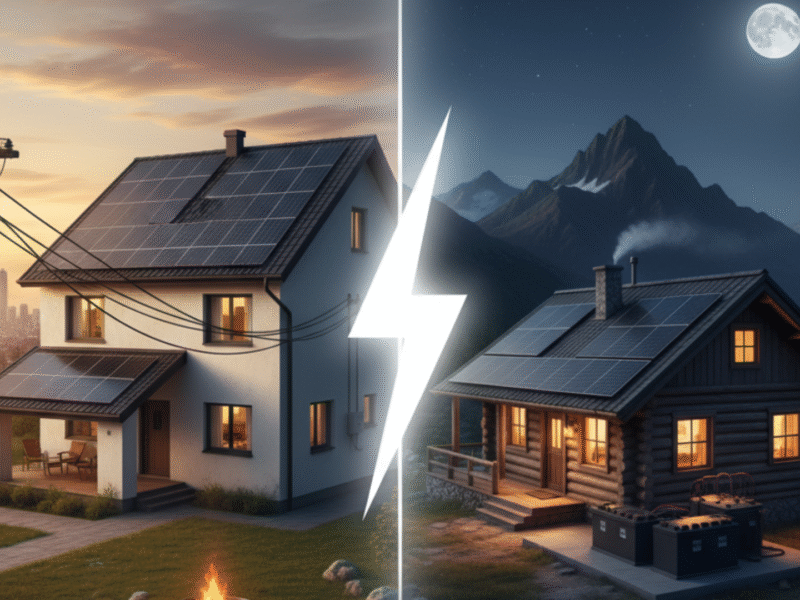
Choosing a solar system is one of the most impactful long-term investments a homeowner or business can make. The fundamental decision—the backbone of your entire setup—is whether to go On-Grid (grid-tied) or Off-Grid (standalone). This ultimate guide will decisively answer the pressing question: Which is better: on-grid or off-grid solar system? The optimal choice is determined by a careful assessment of your specific location, available budget, and desired level of energy independence.
The Foundations: Understanding On-Grid and Off-Grid Solar Systems
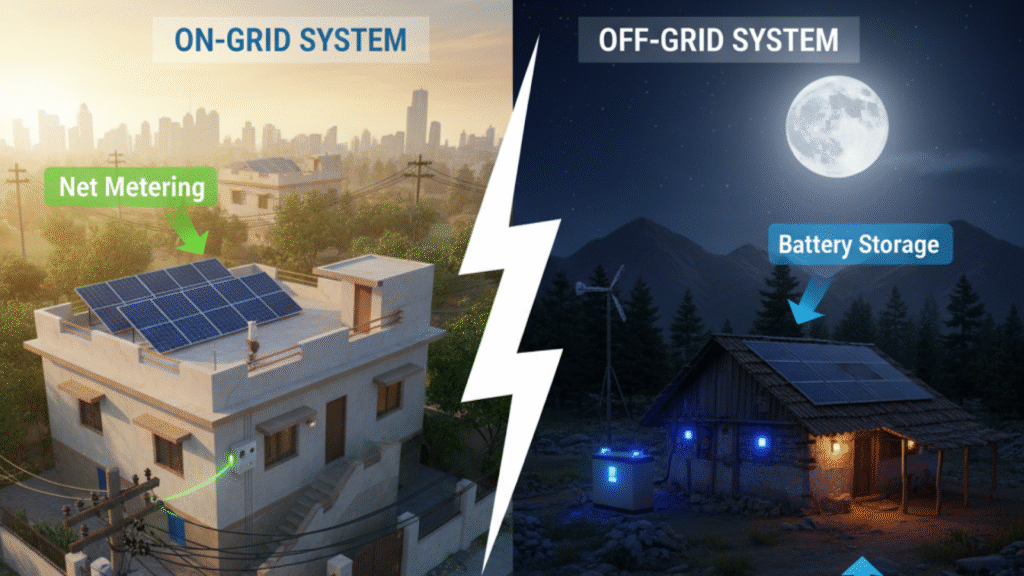
Before evaluating the financials, you must grasp the technical mechanics that separate these two distinct systems.
An on-grid solar system is directly connected to your local utility company’s electrical grid. This connection serves as a giant, instantaneous battery. When your panels produce more power than your home is using—typically during midday—the surplus energy is fed back into the public grid.
- Key Mechanism: Net Metering: This critical billing mechanism credits you for the electricity you export. Later, when your panels are not producing (like at night), you draw power back from the grid, and your credits offset those charges. This greatly reduces your monthly electricity bill, offering the fastest financial return.
- The Trade-Off: For safety reasons, most on-grid inverters have an “anti-islanding” feature. This means that if the main utility grid goes down (a power outage), your solar system is legally required to shut off instantly. Therefore, a standard grid-tied setup does not provide backup power during a blackout.
Off-Grid (Standalone) System: Achieving Energy Independence
An off-grid solar system is completely separate from the utility grid. It must be a self-sufficient, all-in-one power plant capable of generating and storing 100% of the energy you need, 24 hours a day, 365 days a year.
- Key Mechanism: Battery Storage: A large battery bank is absolutely essential. All excess power generated during the day is diverted to charge the batteries. This stored energy is then used to power your home at night or on cloudy days.
- The Trade-Off: Because you are fully self-reliant, you must carefully monitor your energy usage. Furthermore, the mandatory battery bank—which accounts for a significant portion of the total cost and requires periodic replacement—is the biggest differentiating factor.
Financial Showdown: Initial Cost, ROI, and Long-Term Value

When evaluating which is better: on-grid or off-grid solar system, the financial implications are often the deciding factor.
Initial Investment: A Clear Cost Advantage for On-Grid
| Cost Factor | On-Grid Solar System | Off-Grid Solar System |
| Initial System Cost | Lower (Baseline) | High (30% to 50% Higher) |
| Battery Bank | Not required (Optional for backup) | Mandatory and most expensive component |
| Inverter Type | Standard Grid-Tied Inverter | Hybrid or Off-Grid Inverter + Charge Controller |
| Permitting/Interconnection | Required for utility approval | Only standard building permits required |
The upfront cost of an off-grid solar system is substantially higher, primarily due to the inclusion of the large, sophisticated, and expensive battery bank and the necessary charge controllers. Therefore, if minimizing the initial cash outlay is your primary concern, on-grid is the clear winner.
Return on Investment (ROI) and Lifetime Costs
The financial comparison extends far beyond the installation day.
- On-Grid ROI: The return is fast and straightforward. Your ROI comes from the immediate reduction in your monthly electricity bill, often allowing the system to pay for itself in 4 to 8 years, depending on your local electricity rates and solar incentives. The long-term maintenance is minimal, mainly panel cleaning and eventual inverter replacement (every 10-15 years).
- Off-Grid Lifetime Costs: While you eliminate your monthly utility bill (zero cost avoidance), you incur a significant recurring expense: battery replacement. Batteries, whether Lead-Acid or Lithium-ion, have a finite lifespan and must be replaced every 5 to 15 years, representing a massive long-term investment that substantially impacts the total cost of ownership.
Operational Comparison: Power Security and Maintenance Needs
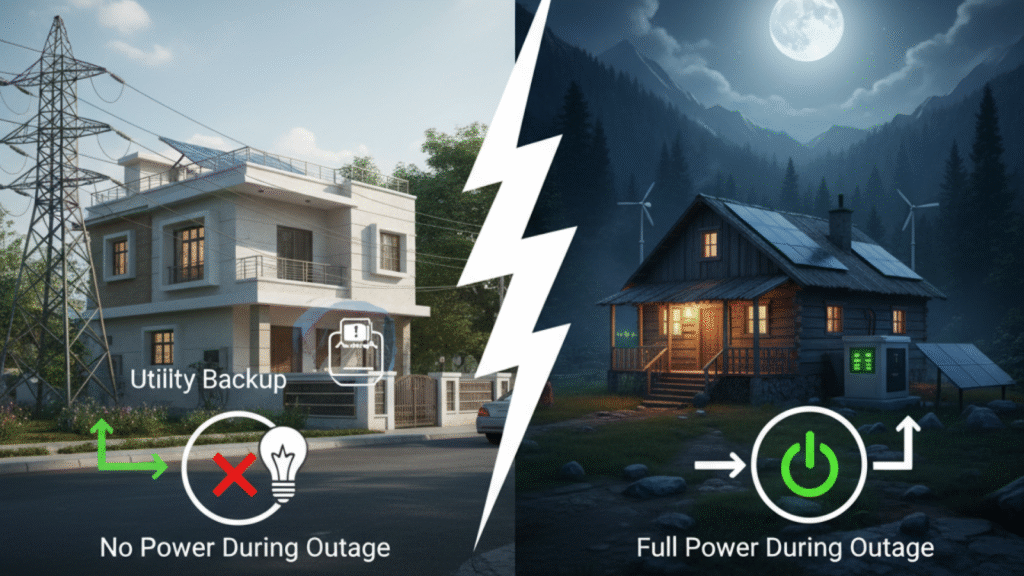
Beyond cost, the day-to-day realities of power availability and system upkeep are crucial in determining which is better: on-grid or off-grid solar system.
Reliability and Power Security in a Solar System
| Operational Aspect | On-Grid Solar System | Off-Grid Solar System |
| Power During Outage | No Power (Must shut down for safety) | Full Power (Runs off stored battery power) |
| Reliability Source | Utility Grid provides backup 24/7 | Battery Storage provides backup; sun provides charge |
| System Capacity | Can be sized to offset 100% of usage | Must be sized for peak winter/cloudy day usage |
| Energy Waste | Minimal (excess sold to grid) | Potential (batteries may reach capacity) |
If you live in an area with a highly unstable grid or frequent natural disasters, a standalone solar setup offers superior power security because it continues to function when the grid fails. This is a primary driver for many homeowners choosing the more expensive option. Conversely, if your grid is exceptionally reliable, the 24/7 backup from the utility makes a grid-tied setup the most convenient choice.
Maintenance and System Management
The complexity of the system directly impacts maintenance requirements. On-grid solar systems are very low maintenance—you just need to keep the panels clean. Conversely, an off-grid solar system is high maintenance due to the battery bank, which requires regular monitoring, specific temperature control, and often maintenance to ensure longevity.
The Middle Ground: Considering the Hybrid Solar System
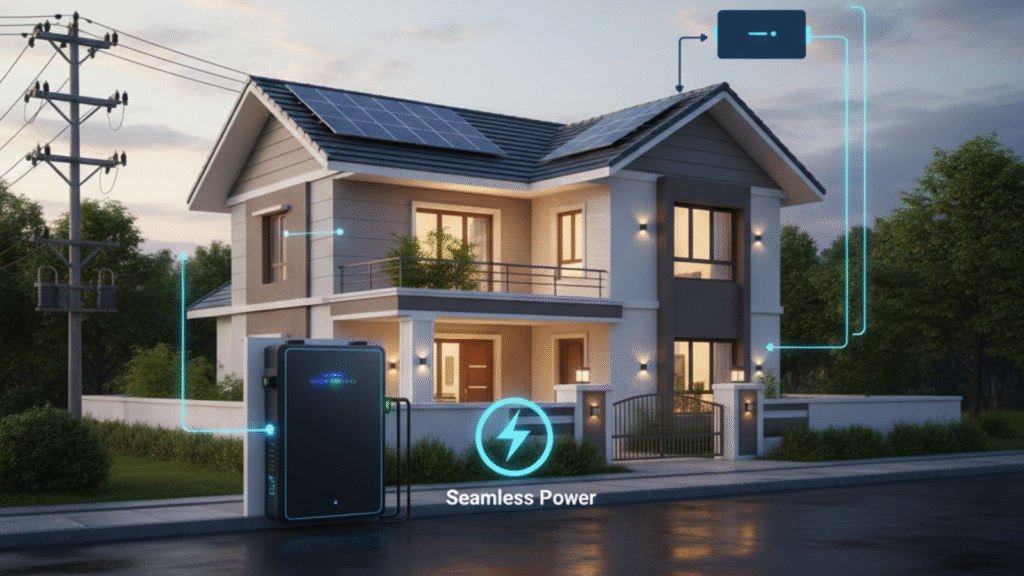
Before finalizing which is better: on-grid or off-grid solar system, it is essential to consider the Hybrid Solar System. This setup offers the best compromise.
A hybrid system is grid-tied (allowing for Net Metering benefits) but also includes a battery bank and a sophisticated hybrid inverter.
- Best of Both Worlds: It allows you to sell excess power back to the grid for credits and gives you automatic, seamless backup power when the grid fails.
- Optimal Use: This system is ideal for homeowners who want to save money monthly and protect critical loads (lights, refrigerator, Wi-Fi) during power outages. It is the most flexible, but also the most complex and expensive of the grid-connected options.
Final Verdict: Making Your Decision
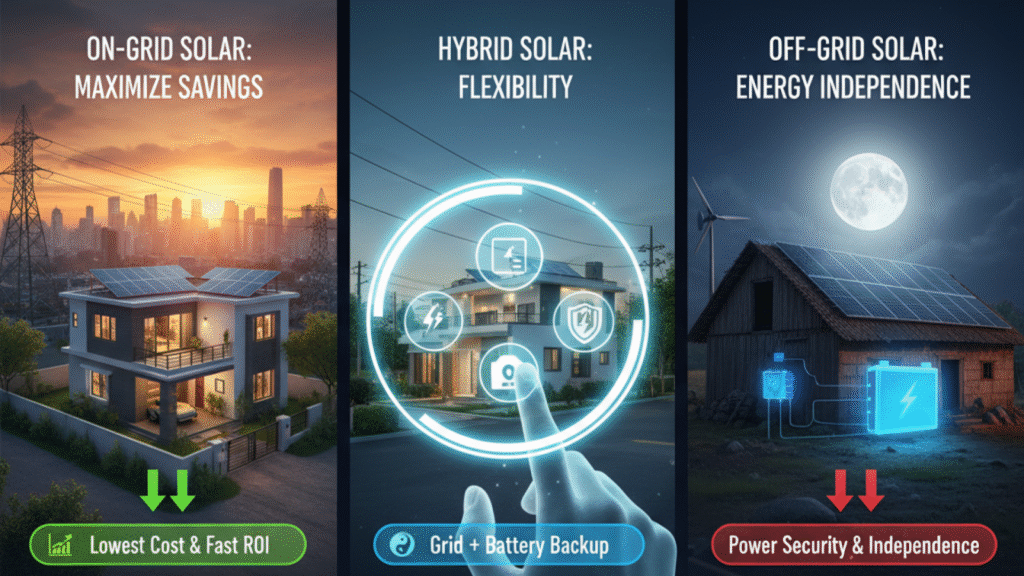
The ultimate choice boils down to prioritizing one of these three factors:
- Lowest Cost & Fastest Financial Return: Go Grid-Tied.
- Highest Power Security & Complete Independence: Go Standalone (Off-Grid).
- Maximum Flexibility & Outage Protection: Go Hybrid.
For the vast majority of residential users in established, grid-connected communities, the Grid-Tied system is superior. It offers the fastest path to significant savings and a strong Return on Investment (ROI). The higher complexity and expense of the Standalone solar option is only justified when connecting to the utility grid is physically or economically impossible, or when absolute energy independence is a non-negotiable personal goal.is physically or economically impossible, or when absolute energy independence is a non-negotiable personal goal.
Frequently Asked Questions (FAQ): Which is Better: On-Grid or Off-Grid Solar System?
Q1. Does a Standard Grid-Tied Solar System Provide Power During an Outage?
A. No, a standard grid-tied solar system must shut down immediately when the utility grid fails. This is a critical safety feature, often called “anti-islanding,” designed to protect utility workers who may be repairing the power lines. Therefore, if your priority is blackout protection, the standalone (off-grid) option or a hybrid setup is the better choice. If you want your solar to provide backup power, you must install a battery (a hybrid system).
Q2. Is it Possible to Go Off-Grid in an Urban Area?
A. Technically yes, it is possible. However, it is usually not recommended or financially practical. The high cost of the necessary large battery bank, plus the need for a massive system to cover all potential usage without utility backup, makes it far more expensive than a grid-tied system. Furthermore, many utility companies may have regulations against completely disconnecting from the main grid. For urban settings, the on-grid solar system is almost always the more sensible choice.
Q3. What is Net Metering and Why is it Important for On-Grid Solar?
A. Net Metering is a crucial billing mechanism used by utility companies that significantly improves the ROI of an on-grid solar system. It allows your bidirectional meter to run backward when your solar panels produce more electricity than you use. The utility credits you for this excess power, which then reduces the amount you pay for the power you draw from the grid at night. Without a favorable net metering policy, the financial case for choosing an on-grid system is substantially weaker.
Q4. How Long Do Batteries Last in an Off-Grid Solar System?
A. The lifespan of solar batteries varies significantly by type and usage, but replacement is the single largest long-term cost of an off-grid solar system:
- Flooded Lead-Acid Batteries: Typically 5–7 years (require regular maintenance).
- Lithium-Ion (Li-ion) Batteries: Generally 10–15 years (higher upfront cost, but almost zero maintenance).
Conclusion: Making Your Final Decision on Which is Better: On-Grid or Off-Grid Solar System?
For the vast majority of homeowners connected to a stable utility grid, the On-Grid solar system is superior. It offers the lowest upfront cost, the highest return on investment through Net Metering, and minimal maintenance. This system is designed to save you money quickly and efficiently.
Conversely, the Off-Grid solar system is the only viable option for those in remote locations without grid access, or for those who prioritize absolute freedom from the utility company, regardless of the higher installation and long-term maintenance costs.
If you seek the best of both worlds—maximum financial savings plus reliable blackout protection—the Hybrid Solar System is your ideal solution. By clearly defining your budget, location, and power goals, you can confidently choose the right system to power your future.

